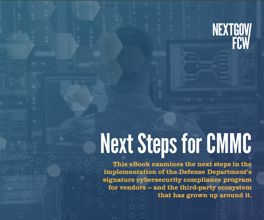2022 Defense Authorization Bill (Once Again) Looks to Reform How DOD Buys Tech

Dmytro Lastovych/iStock
National Defense Authorization Act provisions sparked support and skepticism from several experts.
The latest military spending authorization comes with plans to increase the Pentagon’s pace and scope of technology innovation. Though generally pleased with the bill, former federal officials warned new bureaucratic hurdles within it could stymie that work.
President Joe Biden on Monday signed the massive National Defense Authorization Act for fiscal year 2022, which approves more than $768 billion in defense spending—noticeably more money than the White House proposed. Its expensive investments were partly fueled by concerns that grew in 2021 about whether the Pentagon can modernize and gain novel capabilities fast enough to thwart American adversaries.
“First of all, I think it is fantastic that this bill was passed,” former Defense Undersecretary for Acquisition and Sustainment Ellen Lord told Nextgov on Wednesday. “Really getting to a bipartisan bicameral bill in this environment is difficult, so I think everyone deserves a lot of credit for that. And I think, overall, it's a pretty strong bill.”
Lord and four other experts who work with or have served in the U.S. government briefed Nextgov this week on how the NDAA might empower the Defense Department with funding and guidance to pursue new technologies and acquisition approaches fit for next year’s challenges.
“This NDAA will undoubtedly help [DOD] accelerate innovation, which is critical to staying ahead of adversaries,” Bob Stevens, area public sector vice president at DevOps platform GitLab, said.
Competitive Investments
Broadly, the more than 2,100-page legislation outlines priorities and provides a framework for appropriators who will eventually pass the department’s budget. It includes a number of requirements that will result in major impacts for DOD officials, such as its authorization of a 2.7% pay raise and an increase to parental leave time for U.S. military troops
On top of establishing a new national security commission to study emerging biotechnology applications and a federal office and authorities to investigate DOD’s encounters with UFOs, the act also incorporates a variety of measures to ramp up the Pentagon’s deployments of emerging technologies like those associated with quantum information science, space-based assets or artificial intelligence.
“The NDAA included new investments in AI, new pathways for recruiting much-needed talent and new pilot programs for acquiring tech for warfighters,” Megan Lamberth, associate fellow in the Center for a New American Security’s Technology and National Security Program, explained. “Investments, talent and effective institutional processes are all necessary components for U.S. tech competitiveness.”
She added that she was “excited” to see several of the National Security Commission on AI’s comprehensive review-based suggestions make it into the final version of the bill.
“The DOD is moving forward to advance AI in military systems and operations,” Pete Modigliani, defense software acquisition lead at Mitre also noted. “Congress is keeping the pressure on the DOD to implement the key recommendations of the [NSCAI] and the Defense Innovation Board.”
Despite excluding some previously proposed cybersecurity requirements, the NDAA has a provision that directs DOD’s chief information officer and the U.S. Cyber Command commander to “jointly develop a zero-trust strategy, principles and a model architecture to be implemented” across the department’s information network—and specifically in its classified networks, operational technology and weapon systems.
Proliferating, advanced and persistent threats escalate the government’s need to rapidly launch systems and capabilities that are secure by default, according to GitLab’s Stevens.
“I appreciate the NDAA’s proactive focus on zero-trust, including strategically enabling rapid pivot and remediation as zero-day vulnerabilities and discoveries requiring an immediate reaction emerge,” he said. “The NDAA provides reasonably specific cyber guidance compared to high-level recommendations we have seen.”
During the Cold War in the 1960s, the federal government was funding close to 70% of the nation’s total research and development activities—but that percentage has dropped over the past few decades, CNAS’ Lamberth noted. Increases in investments for the department’s R&D initiatives, including nearly $117 billion for fresh science and technology efforts, are also part of this NDAA.
“We know from American history how important federal R&D spending is for sustained U.S. innovation,” Lamberth said. “I think this increase in funding is necessary and represents the growing bipartisanship on the issue of ensuring U.S. tech competitiveness.”
To Mike Hettinger, president and founding principal of Hettinger Strategy Group and former House of Representatives Republican Leadership chief of staff and committee staff director, this funding boost is “both interesting and welcome.”
“These increases were offered primarily in response to issues of competition with China,” he noted. “I believe the increased focus and the potential broadening of the applicability will likely bring more R&D players into the DOD ecosystem.”
He said overall he’s pleased to see the NDAA’s “focus on technology and cybersecurity.”
Spotlighting Procurement Problems
Among a variety of inclusions to improve the country’s supply chain readiness, the NDAA bars any personal protective equipment purchases from China, Russia, Iran and North Korea. It also prohibits the procurement of all items made by forced labor from China’s Xinjiang Uyghur Autonomous Region.
“I'm concerned that we went pretty light on Russia,” Lord, who now serves on boards and advisory groups, said. “I think that obviously China's the pacing threat and there are a lot of provisions excluding the acquisition of certain items from China, which I think is important for our national security. However, it looks like Russia got a pass, and I think that's problematic.”
Calling the NDAA the “premier piece of policy on national security,” Lord added that in her view this move sends a message to U.S. partners and strategic competitors. She’d also like to see the country engage deeper with Canada, Australia and the United Kingdom to solve ongoing global manufacturing issues.
“I'm very bullish about using technology to illuminate the supply chain,” Lord said. “I wish there was even more language around that.”
Still, the spending authorization also incorporates an array of provisions aimed at improving how the department purchases innovative and evolving technologies.
“Most of what’s in this year’s NDAA regarding the adoption of innovative commercial technology is a continuation of existing policies, or a doubling down on those existing policies,” Hettinger noted. “The continued attention and oversight from Congress are important to making this a reality.”
Section 833 directs the department to create a pilot program “to develop and implement unique acquisition mechanisms for emerging technologies in order to increase the speed of transition of [such] technologies into acquisition programs or into operational use.” Another pilot program, detailed in section 834, is also mandated to ultimately accelerate DOD’s procurement and fielding of innovative technologies.
“The law, [Federal Acquisition Regulation] and DOD policies already provide ample preference and flexibilities to acquire commercial solutions, yet there continue to be obstacles in effectively doing so,” Mitre’s Modigliani said. “Sections 833 and 834 are classic examples of Congress seeking to help and push the DOD, yet imposing added bureaucracy and micromanagement in the execution of good-intended provisions.”
While the text directs Pentagon leaders to identify new priority defense modernization projects and develop unique acquisition plans with novel practices on evaluating price, cost estimation, market research, metrics, intellectual property and more, its downside is that “any selected pilot program has a massive amount of oversight from across [the department and] military services with increased reporting to Congress and burdens beyond executing their programs,” he noted.
As GitLab’s Stevens sees it, the NDAA “isn’t overhauling the procurement process, but it will help fast track it.” He said the pilots seem to be designed to prioritize a platform concept that brings different siloed solutions and vendors together, making it easier to add new capabilities.
“The proposed programs represent welcomed steps forward,” Stevens said. “However, new technology can only make a difference if its deployment is not burdensome, and the benefit is measurable.”
Several directions in the bill also focus on the need to reduce DOD’s software technical debt and migrate legacy information technology systems to more secure cloud environments.
Tucked into the NDAA is a provision to modify the Joint Common Foundation, or JCF—the DOD Joint Artificial Intelligence Center’s program and cloud-based experimentation tool built to test and develop AI—to ensure that department components “can more easily contract with leading commercial artificial intelligence companies to support the rapid and efficient development and deployment of applications and capabilities.”
A separate section of the legislation would require DOD to expand the Defense Innovation Unit’s ongoing pursuits to engage and collaborate with private-sector industry and communities “to accelerate the adoption of commercially developed advanced technology in modernization priority areas and such other key technology areas as may be identified by the secretary,” and to increase outreach to communities, and specifically economically disadvantaged ones, that don’t have access to the innovation hub.
“It is encouraging to see the role of the Defense Innovation Unit further strengthened,” Stevens said. “The NDAA gives DIU the latitude to not just prototype, but to buy technology rapidly to accelerate the government’s mission.”
Hettinger added that much of the Biden administration’s focus has been on ensuring traditionally disadvantaged communities and sectors have access to government resources—and that this provision “seems like a continuation of that focus.”
Agreements under DOD’s other transaction authority, or OTAs, enable the agency to use a simplified contracting methodology to expedite the procurement process and quickly access modern commercial products. The NDAA requires officials to review DOD’s current use, authorities, regulations and policies associated with OTAs, and assess whether they should be modified or broadened. It could eventually add more transparency to the process and potentially make OTAs look a lot more like traditional procurements.
“As OTA use has expanded in recent years, so too has Congress’s focus on their use, seeking to ensure transparency in the process,” Hettinger explained. “I think what comes out of this review might bring significant changes.”
Moving Forward
Several of the officials pointed to the noteworthiness of section 1004 in the NDAA, which formally establishes the independent ‘“Commission on Planning, Programming, Budgeting and Execution Reform,” within the legislative branch.
“If the right commissioners are appointed, they have a unique opportunity to modernize the 60-year-old PPBE process for the twenty-first century,” Modigliani, who is also a former Air Force program manager, noted. “That will have massive impacts to accelerate technology development, focus investments smartly, be responsive to changes in operations, threats and technologies, and provide the proper balance of flexibility and transparency.”
Lord pointed out that the provisions refined by this mandate date back to the 1960s. The U.S., she said, needs to update its budget processes to keep pace with today’s technologies.
“So, I have great expectations that a lot will be done on that in 2022, and I think it's really important because Congress has done an admirable job of giving new acquisition authorities and now they all need to really be implemented,” Lord explained. “However, I don't think the budgeting process allows us to move as quickly as we would like to. And with the pacing threat of China, that's becoming a larger and larger issue.”
While it’s helpful that the process will be reviewed and likely revamped, she said that budgeting process modifications should be mandated “very soon.”
“I'll be interested in seeing how the department continues to try and address institutional roadblocks and cultural barriers to adopting and deploying emerging technologies—a long-term, evolving challenge,” Lamberth said. “I think the NDAA got a lot of things right, but the implementation of its provisions is key.”
A few of the officials additionally highlighted that DOD ultimately needs to secure enough personnel who are equipped to implement the legislation’s heaps of directions.
“Within Title XIII, there are [roughly] 56 sections to include new authorities, assessments, pilot programs, changes to state and additional reporting,” Modigliani said. “The biggest challenge is the Pentagon headquarters staff is already stretched thin, operating with acting leadership for the last year or two in many key positions and every year has dozens of new provisions to implement above and beyond any internal initiatives they want to pursue.”
Lord further noted that only a small number of those defense procurement-focused political appointees have been confirmed by Congress, at this point.
“There are a lot of very talented career employees, but career civilian employees are not going to want to lean forward and implement something that their new boss might not be supportive of—and so that leaves everybody in a bit of a stalemate here, relative to moving forward,” she said. “So, one of the biggest boosts to acquisition reform will be getting the political appointees nominated, getting their hearings, getting them confirmed and getting them in place.”
NEXT STORY: What’s next for FedRAMP?



